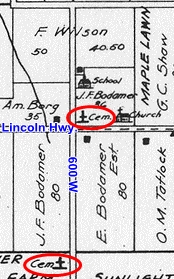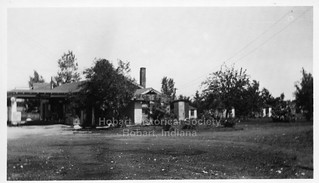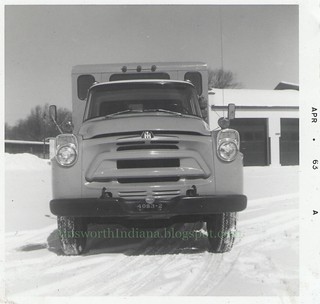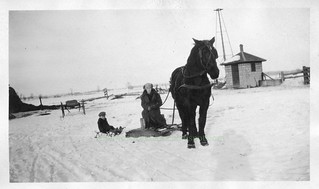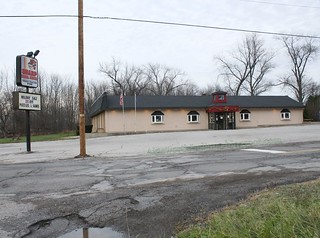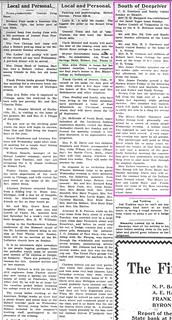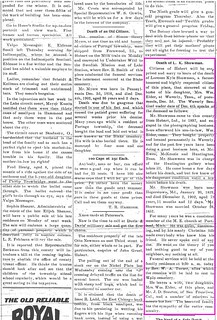What shall I say of the Giertz — Gertz — Gerts — however you spell it — family?
I haven't said much about them so far. When I found out that Mrs. Charles Ols had been born Louise Giertz, I
didn't go trumpeting it about; I just quietly cited her father's obituary as one source of my knowledge of that branch of the Ols family.
I haven't said much because I didn't know much, because I wasn't paying much attention, because I wasn't really interested.
Then last summer I was going through the "Lake County Record of Recognizance Bonds" at the Merrillville/Ross Township Historical Society museum, and found this:
 (Click on image to enlarge)
(Click on image to enlarge)
Image courtesy of the Merrillville/Ross Township Historical Society.
At first I was more intrigued by Christian Kegebein. Was he related to the
north-of-Ainsworth Kegebeins? I haven't been able to figure that out yet. I think I've found Christian Kegebein in the 1870 Census: a 60-year-old German immigrant farming in Ross Township with his wife, Mary (also 60), and Caroline, their 13-year-old daughter (or some kind of relative; she has the same surname). After that he vanishes.
But when I came across this little tidbit in the "General News Items" of the
Hobart Gazette of Oct. 24, 1902: "It is reported that Frank Gertz quietly left Ainsworth early last week and that many creditors are wondering where he is" — that's when I started getting interested in the Giertzes. A guy slipping out of town to avoid creditors … his mother once accused of assault and battery … they sound like fun.
I'd paid enough attention to preserve the obituaries of the elder Giertzes. So I know that the Giertz family consisted of John, Hannah, and an uncertain number of children, including Louise and Frank.
Hannah died first, in December 1901:
 (Click on image to enlarge)
(Click on image to enlarge)
"Mortuary Record," Hobart Gazette 13 Dec. 1901.
No doubt her survivors found comfort in seeing all these nice things printed about Hannah, but this obituary doesn't help us as much as a prosaic listing of the children's names would.
John's obituary, from March 1910, only deepens the mystery.
 (Click on image to enlarge)
(Click on image to enlarge)
Hobart Gazette 11 March 1910.
If we're to believe this, John had two more children in total than he had with Hannah. Where did they come from — his first marriage?
Turning to the census records, I think I've found John and Hannah in 1870, farming in Mason County, Illinois. They have five children: Mary (born ca. 1856), Fred (ca. 1858), Albert (ca. 1865), Americus (ca. 1868), and baby Joseph (1870). If the marriage date given in Hannah's obituary (1855) is correct, these children are all by Hannah.
Sometime after August 1870, they move into Indiana and resume farming in Ross Township. I can't find them in any plat map; I can only judge by their apparent neighbors in the 1880 census in placing them in the eastern part of the township. At that time, John and Hannah had five children: Albert (born ca. 1866), Lucinda (ca. 1869), John Jr. (ca. 1871), Minnie (ca. 1878), and Frank (1880). Also in the household is John's 76-year-old father-in-law, Christopher Carbiene.
Now I'm wondering whether the Christian Kegebein of the recognizance bond and the 1870 census could be the same person as the Christopher Carbiene of the 1880 census. Who better to post bond for Hannah than her own father? — But could enumerator confusion account for the difference in names and ages?
In 1900 John and Hannah are living in their own little household, next door to their son, Frank (who had married Minnie Miller* in December 1898 and now had a baby daughter). Again judging by their neighbors, I think they were living more or less in the village of Ainsworth. (I wonder if they were living in those two little houses just north of the tracks on the west side of S.R. 51 — both had been built by then, if the county property records are correct. And in January 1902 we find "Agent Griffith," presumably Elmer Griffith, the Grand Trunk station telegraph operator, moving "into Mr. Giertz's house," so it likely was convenient to the depot.)
John Giertz died two months before the 1910 census, so we don't find him in the household of Charles and Louisa Ols. Louisa's ages in the various censuses place her birthdate around 1878, so perhaps she was the Minnie of the 1880 census.
I'm still confused.
____________________
*I have no idea whether she was related to Ainsworth's
John Miller.
Sources:
♦ 1870 Census.
♦ 1880 Census.
♦ 1900 Census.
♦ 1910 Census.
♦ 1920 Census.
♦ "Ainsworth News." Hobart Gazette 24 Jan. 1902.
♦ Indiana Marriage Collection.















